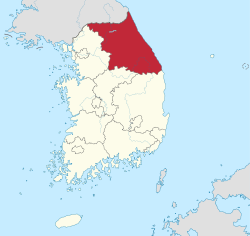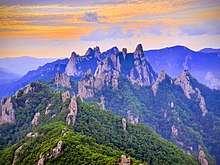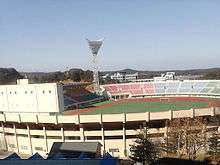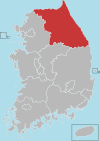Gangwon Province, South Korea
Gangwon-do (Korean pronunciation: [kaŋ.wʌn.do]) is a province of South Korea, with its capital at Chuncheon. It is bounded on the east part by the Sea of Japan, and borders Gyeonggi Province to its west, and North Gyeongsang Province and North Chungcheong Province to its south. Its northern boundary is the Military Demarcation Line, separating it from North Korea's Kangwŏn Province. Before the division of Korea in 1945 Gangwon and Kangwŏn formed a single province. Pyeongchang County hosted the 2018 Winter Olympics and 2018 Winter Paralympics. Gangwon will host the 2024 Winter Youth Olympics.
Gangwon 강원도 | |
|---|---|
| Korean transcription(s) | |
| • Hangul | 강원도 |
| • Hanja | 江(水)原道 |
| • McCune‑Reischauer | Kangwŏndo |
| • Revised Romanization | Gangwon-do |
 Flag  | |
 | |
| Coordinates: 37°30′N 128°15′E | |
| Country | South Korea |
| Region | Gwandong (Yeongseo: western Gangwon; Yeongdong: eastern Gangwon) |
| Capital | Chuncheon |
| Subdivisions | 7 cities; 11 counties |
| Government | |
| • Governor | Choi Moon-soon (Democratic) |
| Area | |
| • Total | 16,875 km2 (6,515 sq mi) |
| Population (April, 2016[1]) | |
| • Total | 1,564,615[2] |
| • Density | 90/km2 (200/sq mi) |
| Metropolitan Symbols | |
| • Flower | Royal azalea |
| • Tree | Korean pine |
| • Bird | Red-crowned crane |
| ISO 3166 code | KR-42 |
| Dialect | Gangwon (Yeongseo: western Gangwon dialect; Yeongdong: eastern Gangwon dialect) |
| Website | gwd.go.kr |
History
Gangwon-do was one of the Eight Provinces of Korea during the Joseon Dynasty. The province was formed in 1395, and derived its name from the names of the principal cities of Gangneung (강릉; 江陵) and the provincial capital Wonju (원주; 原州).
In 1895 Gangwon-do was replaced by the Districts of Chuncheon (Chuncheon-bu; 춘천부; 春川府) in the west and Gangneung (Gangneung-bu; 강릉부; 江陵府) in the east. (Wonju became part of Chungju District.)
In 1896 Korea was redivided into thirteen provinces, and the two districts were merged to re-form Gangwon-do Province. Although Wonju rejoined Gangwon-do province, the provincial capital was moved to Chuncheon, where it remains today.
In 1945 Gangwon-do (along with the rest of Korea) was divided by the 38th parallel north in 1945 into American and Soviet zones of occupation in the south and north respectively, which led to Wonsan joining the province's northern half in 1946 to serve as its administrative center. In 1948, the southern half of the province became part of the new Republic of Korea. As a result of the Korean War Armistice Agreement of 1953, the boundary between the South and North Korean portions of the province was shifted northward to the Military Demarcation Line.
Geography
Location
Gangwon-do is bounded on the west by Gyeonggi-do province, on the south by the provinces of Chungcheongbuk-do and Gyeongsangbuk-do. To the north lies the province's North Korean counterpart, Kangwŏn province. The province's landscape is dominated by the Taebaek Mountains (called Taebaek Sanmaek) which almost reach the sea. As a consequence the coast is very steep.
Regions
Gangwon-do and its North Korean counterpart Kangwŏn are together referred to as the Gwandong region. The region west of the Taebaek Mountains is called Yeongseo, while the region east of the mountains is called Yeongdong. The term "Yeongdong" is frequently used in reference to transportation services from Seoul, the national capital. Thus, one might catch a bus or train on the "Yeongdong Line," or drive to Gangneung on the Yeongdong Expressway.
Climate
Gangwon-do's Köppen climate classification's climate class is sometimes humid subtropical, because in some of its areas, especially in most of Yeongdong, it's Cfa. Otherwise, its climate class is Hot-summer humid continental climate, because it's Dwb in some mountain areas, Dfa in eastern areas, Dfb in eastern mountain areas, and Dwa otherwise. The Taebaek Mountains causes different climates in Yeongdong and Yeongseo.[1]
The climate of Gangwon-do is influenced by the latitude. In summer along with the higher temperature and there is high humidity, but in winter the weather can be very cold owing to high pressure from the east of the Asian continent. According to Korea Meteorological Administration's data, average temperature are very different. In Yongdong, average temperature is 11.0 °C (51.8 °F), and Yeongseo is 10.8 °C (51.4 °F). All of this province's average temperatures range from 6.6 to 13.1 °C (43.9 to 55.6 °F). and the yearly amount of rainfall is 1,300–1,900 millimetres (51.2–74.8 in), and it's concentrated on mountain area. It is one of the snowiest areas in South Korea.[3]
Resources
The full area of Gangwon-do (in North Korea and South Korea) is 20,569 km2 (7,941.74 sq mi),[1] South Korea's Gangwon-do covers 16,874.59 km2 (6,515.32 sq mi). The province is renowned for its agricultural produce, especially potatoes and fish (cuttlefish and pollock). Mineral resources from the province include iron, coal, fluorite, limestone and tungsten. There are some hydroelectric, thermoelectric power plants in the region.
Culture and Heritages

Heritage
It is unknown when the first people of Gangwon began to live, but Paleolithic sites were excavated.[4]
Many historical heritages are in this region, like the Later Silla era's Bell of Sangwonsa, North–South States Period era's Iron Seated Vairocana Buddha of Dopiansa Temple, Goryeo era's Main Gate of Imyeonggwan Guesthouse, and Joseon era's Documents of Sangwonsa Temple. Other popular heritages, like Ojukheon are located.
Because of Gangwon Province's landscape, a number of old Buddhist temples have survived, like Woljeongsa and Oseam.
Museums
Established in 2002, Chuncheon National Museum is operated by the central government for the purpose of classifying and reserving.[5] The local government also has some of museums, including Park Su-geun Art Museum,[6] and Taebaek Coal Museum. Purpose-built private museums, such as ChamSori Gramophone Edison Museum[7] are being operated.
Festivals
In Gangwon Province, almost of the regions hold festivals. Gangneung Danoje was listed in UNESCO's Masterpieces of the Oral and Intangible Heritage of Humanity[8]
Geographically, Gangwon Province has several national parks as well as some natural monuments.
Food
Because of its geographical environment, Gangwon Province is composed of mountains or basins. For the reason, locals mainly make food with potatoes or buckwheat.[9] All regions of the province have seasoned vegetable rice. For example, Jeongseon County is famous with Jeongseon thistle rice; Yeongwol County is famous with Yeongwol buckwheat rolls; Hwacheon County is famous with Hwacheon trout rice in a stone bowl and Hwacheon goatsbeard rice; and Yanggu County is famous with Yanggu dried green radish cuisine.[10][11] In coastal regions, they mainly eat fishes and salted seafood. For example, Donghae City is famous with Donghae steamed fish; Sokcho is famous with Sokcho Squid Sausages; and Samcheok is famous with blowfish soup. These are normally very simple and easy to cook, like the province's traditional food.[9]
Tourism
National Parks & Nature Monuments
Thanks to the Taebaek Mountains, Gangwon Province has 4 national parks & several natural monuments.
- Seoraksan National Park has rocky terrain around the peak, Daecheong-bong. It was also listed in Man and the Biosphere Programme.[12]
- Odaesan is located in the center of Baekdudaegan, and it was assigned as a national park in 1975. Odaesan is one of the holy places of Korean Buddhist cultures.[13]
- Chiaksan is derived from the southwest side of Odaesan, and it's close to Wonju. In 2014, Wonju city & Korea National Park Service collaborated to make walk routes.[14]
- Taebaeksan National Park
- Taebaeksan is a traditional and historical "holy mountain," and it was assigned as a national park on October 22, 2016.[15]
Hantaan River penetrates Cheorwon County's volcanic terrain having several natural monuments. This area was a place of a fierce battle during the Korean War and it is a common rafting route nowadays. Around this river, the first Hantavirus hemorrhagic fever with renal syndrome virus, Hantaan River virus was found. This virus was named after the river.[16] Hantavirus Genus is referred this virus's name.
And, Civilian Control Zone is near to Military Demarcation Line, naturally providing areas to stay for migratory birds, especially red-crowned cranes.[17]
In the township of Haean, Yanggu, specially Haean Basin is nicknamed Punchbowl, which was initially called by a war correspondent for the Korea War.[18]
Tourist Attractions
Gangwon Province has many tourist attractions, as well as natural monuments, e.g., Namiseom, Tong-il Observatory (similar of Dora Observatory), Soyang Dam and Jeongdongjin. A memorial center of the novelist Lee Hyo-seok is in Pyeongchang County. Along the coast of the Sea of Japan, many seaside resorts are located, including Gyongpo Seaside Resort.
The only domestic casino in Gangwon is Kangwon Land, located in Jeongseon County.
The province also houses the largest Ski Resort in South Korea, the Yongpyong Resort.
Transportation
Railway
Gangwon Province's railways were originally built to transport mining resources to harbors.[19][20]
In Gangwon-Province, some main lines are being operated. First of all, Jungang Line is connected to Seoul Metropolitan Subway System. Yeongdong Line and Taebaek Line are derived from the Jungang Line. Gyeonggang Line was constructed, but currently it's not perfectly connected to the Seoul Metropolitan Subway System. KTX trains launched from Seoul to Gangneung on 22 December 2017 via Gyeonggang Line, but they still run a part of the Jungang Line.[21] In 2016, a plan was passed to extend the KTX line from Gangneung to Sokcho.[22]
Gyeongwon Line and North Dong-hae Line of the main lines are blocked by the Military Demarcation Line.
Air
Gangwon Province has several military airbases, while civil passengers can use only two airports, Wonju Airport and Yangyang International Airport. Wonju Airport is shared with the Republic of Korea Air Force, like Daegu International Airport and Gimhae International Airport,[23]
Currently Wonju and Yangyang Airport are now operated as a domestic airport.[24][25]
Road
Total Gangwon Province's road length is 9,800 km (6,100 mi), and the pavement was completed 75.1%.[26] Some historical and traditional ridges have survived, like Daegwallyeong. It has many routes, like a Route 7 which is included in AH6.
It also has Controlled-access highways. Yeongdong Expressway is the first express way in the region, and Gwangju–Wonju Expressway, Jungang Expressway, Donghae Expressway, Seoul–Yangyang Expressway were built, afterwards. Seoul–Yangyang Expressway has the longest road tunnel in South Korea.
Buses
Like the railways, Gangwon Province is connected by intercity bus networks in South Korea. All cities and counties have intercity terminals, which connect other cities or counties in the region or connect outer cities, districts, and Inchon International Airport.
Sea
Gangwon Province has many harbours. Some harbours are a fishing port, but other harbours are used for special purposes. For example, Mukpo Harbour functions as an exporting hub for cement & coal from Taebaek Mountains.[27] Sokcho Harbour functions as a fishing port, a passenger harbour and an exporting hub for iron ore.[27] Also recently, Korea Gas Corporation built the LNG Platform Center in Hosan Harbour.[28]
Gangwon province also has ferry lines. Sokcho Harbour has a pier for cruise ships,[29] but until now 2018, no cruise route exists.
- Domestic Ferry
- International Ferry
- Donghae Harbor – Vladivostok, Sakaiminato, Tottori[32]
Sports
Sport team
Soccer
Gangwon FC bases itself in the region, owned by the Gangwon Province. Jin-seon Kim, the Governor of Gangwon Province announced to establish it on April 28, 2008[33] and it was established on December 18, 2008.[34]
Ice Hockey
High1 is Kangwon Land's Ice Hockey team, established in September, 2009. South Korea has only 3 professional ice hockey clubs, including High1.[35]
Also Daeyung Killer Whales was established in 2016, originally based in the region.[36]
Basketball
Wonju DB Promy is a professional basketball team, based in Wonju, Gangwon Province. It was established 1996. Currently, it donated coals in the collaboration with a local government-owned company, Korea Coal Corporation[37]
List of All Gangwon Province's sport clubs

| Leagues | Team Name | Est. |
| K League 1 | Gangwon FC | 2008 |
| Korea National League | Gangneung City FC | 1999 |
| K3 League Advance | Chuncheon FC | 2010 |
| K3 League Basic | Pyeongchang FC | 2008 |
| WK League | Hwacheon KSPO WFC | 2011 |
| KBL | Wonju DB Promy | 1996 |
| Asia League Ice Hockey | High1 | 2004 |
| Asia League Ice Hockey | Daemyung Killer Whales | 2016 |
Significant Sport Events
The 1999 Asian Winter Games were held in Gangwon Province between 30 January and the 6th of February 1999. South Korea, the host nation ranked 2nd in these games.
The 2018 Winter Olympics was held from 9 to 25 February 2018 and the 2018 Winter Paralympics was held from 9 to 18 March 2018. Almost all of the events were held in Pyeongchang County. Alpine skiing events were held in Jeongseon County, while some of indoor events were held in Gangneung.
The 2024 Winter Youth Olympics is scheduled to be held in Gangwon Province.
Municipalities
The main cities of the province are Chuncheon (the provincial capital), Gangneung, Sokcho, Wonju, and Donghae. Currently Gangwon Province, has 7 cities, and 11 counties[38]
| Map | # | Name | Hangul | Hanja | Population (2016)[39] | Subdivisions |
|---|---|---|---|---|---|---|
 | ||||||
| — City — | ||||||
| 1 | Wonju | 원주시 | 原州市 | 341,130 | 1 eup, 8 myeon, 16 haengjeong-dong | |
| 2 | Chuncheon (Capital city) | 춘천시 | 春川市 | 283,951 | 1 eup, 9 myeon, 15 haengjeong-dong | |
| 3 | Gangneung | 강릉시 | 江陵市 | 215,721 | 1 eup, 7 myeon, 13 haengjeong-dong | |
| 4 | Donghae | 동해시 | 東海市 | 93,958 | 10 haengjeong-dong | |
| 5 | Sokcho | 속초시 | 束草市 | 82,670 | 8 haengjeong-dong | |
| 6 | Samcheok | 삼척시 | 三陟市 | 70,371 | 2 eup, 6 myeon, 4 haengjeong-dong | |
| 7 | Taebaek | 태백시 | 太白市 | 47,333 | 8 haengjeong-dong | |
| — County — | ||||||
| 8 | Hongcheon County | 홍천군 | 洪川郡 | 70,961 | 1 eup, 9 myeon | |
| 9 | Cheorwon County | 철원군 | 鐵原郡 | 48,699 | 4 eup, 7 myeon | |
| 10 | Hoengseong County | 횡성군 | 橫城郡 | 46,662 | 1 eup, 8 myeon | |
| 11 | Pyeongchang County | 평창군 | 平昌郡 | 43,782 | 1 eup, 7 myeon | |
| 12 | Jeongseon County | 정선군 | 旌善郡 | 38,993 | 4 eup, 5 myeon | |
| 13 | Yeongwol County | 영월군 | 寧越郡 | 40,330 | 2 eup, 7 myeon | |
| 14 | Inje County | 인제군 | 麟蹄郡 | 33,061 | 1 eup, 5 myeon | |
| 15 | Goseong County | 고성군 | 高城郡 | 30,749 | 2 eup, 4 myeon | |
| 16 | Yangyang County | 양양군 | 襄陽郡 | 27,515 | 1 eup, 5 myeon | |
| 17 | Hwacheon County | 화천군 | 華川郡 | 26,489 | 1 eup, 4 myeon | |
| 18 | Yanggu County | 양구군 | 楊口郡 | 24,264 | 1 eup, 4 myeon | |
Claimed
Friendship partners
.svg.png)






See also
- List of Korea-related topics
References
- Gangwon Province (2016-04-27). 자연환경. Gangwon Province (in Korean). Retrieved 2018-02-09.
- 자연환경 (in Korean). 강원도청. 2016-04-27. Retrieved 2018-02-09.
- 국내기후자료 – 강원도 (in Korean). Korea Meteorological Administratione. Retrieved 2018-02-09.
- 노형석 (2016-08-12). 구석기・신석기 선조들 먹고살던 동굴 정선서 발견 (in Korean). 한겨례. Retrieved 2018-02-10.
- 김경석 (2017-10-30). "춘천박물관, 개관 15주년 기념 전시관 재개관 개막" (in Korean). 뉴스1. Retrieved 2018-02-10.
- 정성원 (2018-01-29). "'박수근 고향' 양구, 박수근을 입었다" (in Korean). 조선일보. Retrieved 2018-02-10.
- 최보식 (2010-12-20). "[최보식이 만난 사람] 강릉 '참소리 축음기·에디슨 박물관' 손성목 관장" (in Korean). 조선일보. Retrieved 2018-02-10.
- "강릉단오제" (in Korean). Korea National Commission for UNESCO. Archived from the original on 2018-02-10. Retrieved 2018-02-10.
- "강원도 전통음식의 특징" (in Korean). 한식아카이브. Archived from the original on 2018-02-10. Retrieved 2018-02-10.
- "강원도 대표음식 30선" (in Korean). 강원도청. Retrieved 2018-02-13.
- 신효재 (2016-12-30). "[영상]"강원도 대표 먹거리 30선"" (in Korean). 뉴스1 강원. Retrieved 2018-02-10.
- "Mount Sorak" (in Korean). UNESCO & Man and the Biosphere Programme. Retrieved 2018-02-10.
- "오대산국립공원 지정 43주년을 맞이하여" (in Korean). 강원도민일보. 2018-02-05. Retrieved 2018-02-10.
- "치악산국립공원 지역에 68km 둘레길 생긴다" (in Korean). 연합뉴스. 2014-11-19. Retrieved 2018-02-10.
- 김정수 (2016-04-15). "'민족의 영산' 태백산 스물두번째 국립공원 되다" (in Korean). 한겨례. Retrieved 2018-02-10.
- 유기현 (2010-10-25). "유행성출혈열 백신을 찾아낸 의학자, 이호왕" (in Korean). 한겨례. Retrieved 2018-02-10.
- 천권필 (2018-01-28). "철원 평야…전세계 두루미 30% 찾는 '철새 낙원'된 이유는" (in Korean). 중앙일보. Retrieved 2018-02-10.
- 이진욱 (2015-12-11). "<걷고 싶은 길> 최북단 숲길 양구 펀치볼 둘레길" (in Korean). 연합뉴스. Retrieved 2018-02-10.
- "태백선" (in Korean). 한국민족문화대백과사전. Retrieved 2018-02-09.
- "영동선" (in Korean). 한국민족문화대백과사전. Retrieved 2018-02-09.
- 이은정 (2017-12-22). 경강선 KTX 개통…서울-강릉 반나절 생활권 열렸다. 동아일보 (in Korean). Retrieved 2018-02-09.
- 춘천∼속초 동서고속화철도 예비타당성 통과…사업 확정(종합) (in Korean). 연합뉴스. 2016-07-08. Retrieved 2018-02-09.
- 김귀근 (2018-01-01). "공군 FA-50 편대, '확고한 영공방위 결의' 초계비행". 연합뉴스 (in Korean). Retrieved 2018-02-09.
- "원주공항 – 운영스케쥴" (in Korean). 한국공항공사. Retrieved 2018-02-09.
- "양양국제공항 – 운영스케쥴" (in Korean). 한국공항공사. Retrieved 2018-02-09.
- 총도로연장 (in Korean). 연강원도청. Retrieved 2018-02-09.
- "동해중부 사고다발지역안내". 대한민국 해양경찰청. Archived from the original on 2018-02-09. Retrieved 2018-02-09.
- 유형재 (2014-02-03). "삼척 호산항 6월 개항…LNG 선박 입·출항". 연합뉴스. Retrieved 2018-02-09.
- "속초에 국제 크루즈 터미널 준공" (in Korean). 한겨례. 2017-09-21. Retrieved 2018-02-09.
- "운항정보" (in Korean). 씨스포빌. Retrieved 2018-02-09.
- "노선정보" (in Korean). 씨스포빌. Retrieved 2018-02-09.
- "schedule". DBS Curise Ferry. Retrieved 2018-02-09.
- 이동칠 (2008-11-05). "프로축구연맹, 11일 이사회서 강원FC 창단 승인" (in Korean). 연합뉴스. Retrieved 2018-02-09.
- 허정윤 (2008-12-18). "K-리그 '신상' 강원FC, 공식명칭 및 엠블럼 발표" (in Korean). 스포탈코리아. Retrieved 2018-02-09.
- 김지섭 (2018-01-17). "[어바웃, 이 종목] 퍽 쟁탈전, 퍽! 주먹도 꽂힌다" (in Korean). 한국일보. Archived from the original on 2018-02-09. Retrieved 2018-02-09.
- 김창금 (2016-05-23). "아이스하키 제 3구단 '대명 킬러웨일즈' 출범" (in Korean). 한겨레. Retrieved 2018-02-09.
- 김용 (2017-11-20). 김주성, 원주시에 연탄 1만1000장 기증...직접 배달도 (in Korean). 연스포츠조선. Retrieved 2018-02-09.
- 행정지역 (in Korean). Gangwon Province. Retrieved 2018-02-09.
- 인구수 (주민등록) (in Korean). Gangwon Province. Retrieved 2018-02-09.
- 자매결연지역 (in Korean). 연강원도 국제교류과. Archived from the original on 2018-02-09. Retrieved 2018-02-09.
External links
| Wikimedia Commons has media related to Gangwon-do. |

- Official Provincial Homepage
- 2018 Pyeongchang Winter Olympics, Official Homepage

